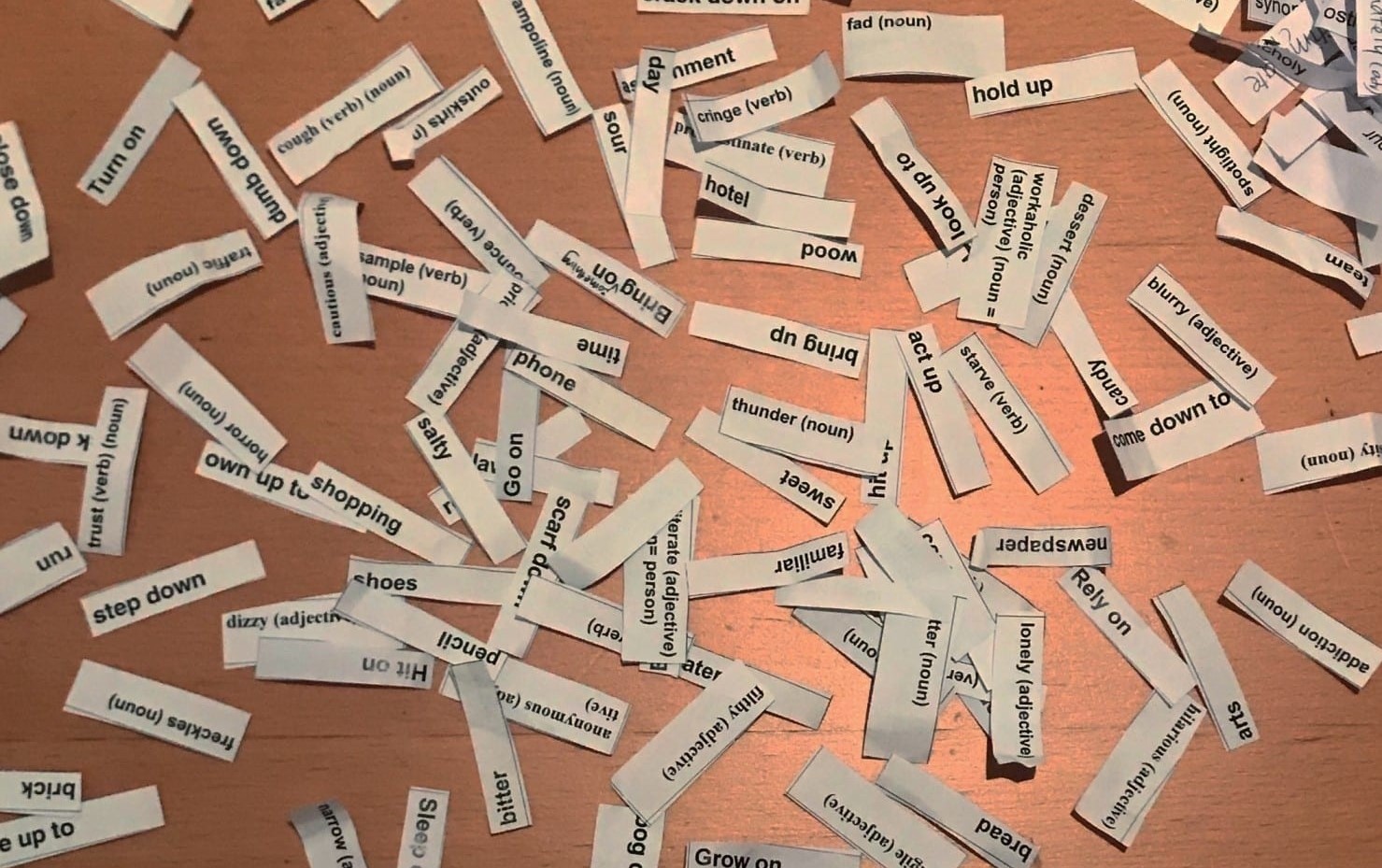Vocabulary is an important part of every lesson, regardless of which skill we are focusing on. Teaching vocabulary is a little different than teaching grammar, writing or other skills. Many students identify vocabulary as one of the main areas in which they want to see improvement. Many ESL teachers, on the other hand, struggle with the challenge of helping students expand their vocabulary and maintain their active vocabulary bank. A strong vocabulary has a beneficial effect on all skill areas, and helping students improve in this area should be a priority for ESL teachers.
There are many things to consider when teaching new vocabulary to ESL students, but one of the first is to look at what we mean when we say students ‘know’ a word. Do we mean they can recognize the word and roughly decipher its meaning when they encounter it in a text? Do we mean they can use the word (and all its forms) accurately in speaking and writing?
This OnTESOL graduate blog will teach you 5 principles that ESL teachers need to follow in a new vocabulary lesson.
Online TESOL / TEFL courses by OnTESOL. Institutionally accredited in the United States.
Save 35% with the 168-hour Hybrid TEFL Certificate course!
1. Activate Schema to Introduce New Vocabulary
Activating schema is an essential part of introducing new vocabulary. In most cases, the majority of the vocabulary that your students end up using in a lesson comes directly from you and the materials you’ve chosen.
Introducing vocabulary is usually best done in context. It’s not so effective to start a lesson by giving your students a list of 15 new words. And having them read their definitions. At that early point, they haven’t activated their prior knowledge. And they are not clearly seeing the purpose of the words.
Instead, introduce the theme and get the students thinking about what they already know. In linguistic terms, we call this activating schema and it is a crucial early step. Start with a short discussion between pairs or groups, for example, that will elicit from students what they already know about the vocabulary in that scheme. In this way, you and the students know where they are and where they need to go. This is called a diagnostic assessment, and it’s a necessary part of effective teaching.
OnTESOL – Accredited TESOL certification courses since 2003
2. Teach Vocabulary in Context
If we want students to move vocabulary into their productive vocabulary (in other words, if we want students to be able to use words accurately), we need to present the new words in context. Students need to know the structural requirements of the word. Is it followed by a specific preposition? Can it be followed by another (with a change in meaning)? Is it a verb used actively or passively? Are their other vocabulary items in the same word family?
Teachers also need to consider the full meaning of a word. Does it have positive or negative associations? Is it more in writing or in speaking, or in both? How is the word different from its synonyms? When we want students to use a word actively, we need to consider these aspects. For ‘passive’ recognition, a more general understanding of the word is enough.
Let’s start by looking at a sequence that takes place in the introduction of new words in a lesson. Imagine that the lesson that you want to teach, in your grammar class, is on the comparative. To teach the comparative, you want to focus on a theme and you have chosen ‘finding an apartment to rent’. When choosing your content and activities, you’ll need to think about what words your students will need to know to be successful in the lesson.
Most importantly, they’ll need to know adjectives which describe those apartments and which will help us compare them. You would assume, also, that they need to know some nouns related to apartments and apartment advertising.
It’s always challenging to know how much vocabulary we want to introduce to students in a single lesson. Part of the problem in making this decision arises from the fact that within a class there are always a variety of levels. Because of this, we need to do some form of what we call differentiated instruction. Here is a strategy you can use in your planning.
Ask students to look at short apartment descriptions, and pick out all of the adjectives, whether they know them or not. For example, they see a collection of online postings that feature a couple of photos and two or three sentence descriptions.
Looking for the adjectives serves two purposes; it gets students thinking about grammar and syntax, and it also gives them some time to think about the meanings of new words. They are going to automatically make some inferences about the meaning of the adjective based on pictures they can see of the apartment and other cues from the text.
Clear up any questions that students still have about the meaning of words after you’ve given clear definitions through context, pictures, and examples. Be careful about asking students if they understand what you’ve just taught them. In many cases, the only way for you to feel confident in their understanding is by asking them to show you their understanding. And you do this by giving them opportunities to work more deeply with the vocabulary.
Online TESOL/ TEFL courses with live workshops offered via Zoom.
3. Build Collocations
You might want to have them create a list of adjectives on the board and then come up with their opposites. Discuss whether or not the new words that you are teaching have a positive or pejorative connotation. This is important information to know when learning any new word.
Then, in order to deepen students’ understanding of the words and to provide opportunities for repetition and memorization, ask students to create mind maps that link new vocabulary with other words. For example, I’ve asked a pair of students to create a map for the word ‘clean’. And I’ve asked them to connect 5 words that they know with it, 4 which are good collocations and one which is not.
Once all pairs have written their mind maps on the board. The class looks at each one and decides which word does not fit. This way, students are strengthening their knowledge of collocations around a word by thinking critically about how words work together. This will help them when they later want to use the words in speaking or writing.
4. Review and Recycle Vocabulary
No matter what words teachers hope their students will learn, it is important to review and recycle vocabulary often. Students need repeated exposure to a new vocabulary item to help it ‘stick’. If teachers want an item to become a part of students’ productive vocabulary, students need to see and use the word frequently. Encouraging students to read newspapers and listen to news can help expose them to frequently used vocabulary, and provides natural review and recycling.
5. Plan for Different Levels
When planning vocabulary to introduce through your lesson, draw a pyramid divided into thirds. On the bottom, third of the pyramid would go the items or concepts (in this case, vocabulary). Which you want every student in your class to be very comfortable with at the end of the lesson. In the middle third are the words and concepts that you expect at least 60% of the class to have successfully understood. In the top third, you want the words (or concepts) that likely only the higher-level students will be able to digest.
This is called planning for differentiated instruction; it attempts to address the ever-present dilemma of different skill levels within one class. You don’t need to actually put one of these pyramids into each of your lesson plans, but it’s useful to understand that you need to have vocabulary and concepts that will challenge students who are at different levels. So, for example, if you’re going to introduce 20 new words over the course of a lesson, you might want to focus more closely on about 15 of them.
You may also want to hand out a chart, at the end of class, that provides extra, more advanced words that students can study on their own if they are up to the challenge. Higher level students do appreciate the opportunity to review words they’ve seen before, but they need to constantly be moving forward just as lower-level students do, and this is one way to help them do that.






Quite engaging and explorative
Vocabulary is my concern to reach reading comprehension goal . The topic today is quite helpful. I have practiced ” Activate Schema ” for many years of teaching in this system because meaning of words from the theme, from exploring the theme and activities ( graphic organizer, Videos, Visual arts …) play a very important role in understanding the reading text later( 70%).
* Oral approaches are used Before, During, and After reading to develop the topic faster and better. Beginners as well as Lower Intermediate students are ready to write a paragraph, a summary, or an essay after reading.
Both levels can present independently the story or the second reading of the unit (LW) by themselves.
* Collocations are learned naturally from the text. I only teach Grammar separately after the text. Review and feedback can’t be missed in teaching.
* I have learned a lot of culture, people, food, music, art and some Chinese, Spanish, French to help my teaching with the students to reach what I need to teach for the day.
+ I don’t practice ‘pyramid’ but I should know what voc students need.
Thank you very much for your blog. At present I have done more research about voc activities to engage my students much more for the new school year.
I ‘d appreciate what you suggested on web.
Thai Dang
ESL at North Quincy High